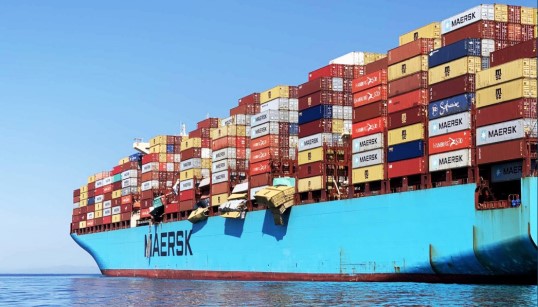- Topics
- Campaigning
- Careers
- Colleges
- Community
- Education and training
- Environment
- Equality
- Federation
- General secretary message
- Government
- Health and safety
- History
- Industrial
- International
- Law
- Members at work
- Nautilus news
- Nautilus partnerships
- Netherlands
- Open days
- Opinion
- Organising
- Switzerland
- Technology
- Ukraine
- United Kingdom
- Welfare

Disturbing new evidence about the risks of parametric rolling affecting containerships has been uncovered during an investigation into the loss of almost 700 boxes from a Maersk vessel last year. Andrew Linington reports
Following an incident in the Pacific last year, the Danish Maritime Accident Investigation Board (DMAIB) has urged maritime companies and authorities to work together to secure more reliable onboard tools to alert seafarers to the threat of parametric resonance.
A total of 689 containers were lost overboard and 258 damaged when the 13,600TEU Maersk Essen rolled heavily some 450nm off Hawaii while enroute from China to the USA, in January 2021.
The ship – which had already changed its route following advice from a weather service – underwent two episodes of heavy rolling within the space of 15 minutes. The inclinometer and subsequent analysis showed that Maersk Essen reached angles of between 26° to 30° -- well above its simulated maximum roll angle and the pre-set operational limit for the loading condition on the voyage, with the operational threshold for the lashing system set at 19.18° roll.
Conditions at the time of the incident were described as normal for the ship and the area, and included a force 6 wind and a swell estimated at 5m. Maersk Essen had encountered similar or worse weather and sea conditions earlier in the voyage without experiencing heavy rolling, the report notes.
However, subsequent analysis showed that the ship had been sailing in conditions with the potential to cause pure loss of stability on a wave crest and parametric roll resonance.
'From previous investigations, DMAIB has found that parametric resonance effect is often considered a rare phenomenon by navigational officers,' the report states. 'This is most likely a false assumption, as the triggering conditions are common.'
While the ship's officers told investigators they knew how to react to stop the heavy rolling caused by parametric resonance, the DMAIB said they had no reliable information or tools readily available onboard to calculate and monitor the risk, and that variations in forecast data sources and calculation models used for predictions can give 'misleading indications' of risk.
'Methods for prediction of risk of parametric rolling by comparing natural roll period with wave encounter period requires ship-specific information and is sensitive towards small variations in ship's speed and wave data,' the report adds. 'This is problematic when risk calculation is based on forecasts and visual sea state observation characterised by uncertainty.'
The report highlights a 'critical dimension' to the way in which the rolling risks faced by Maersk Essen had developed without the crew's awareness – pointing out that some were just minutes away from entering the cargo deck to check the lashings when the heavy rolling began. 'If the crew had been on deck, the collapsing container stacks could have resulted in fatalities,' it points out.
Calling for work to develop tools to predict resonance effects based on actual conditions rather than forecasts, the DMAIB warns that 'accidents are likely to occur again unless effective efforts to avoid the triggering conditions are implemented'.
Tags
